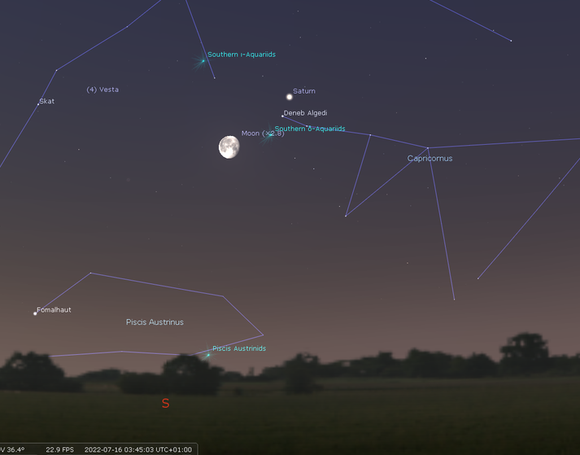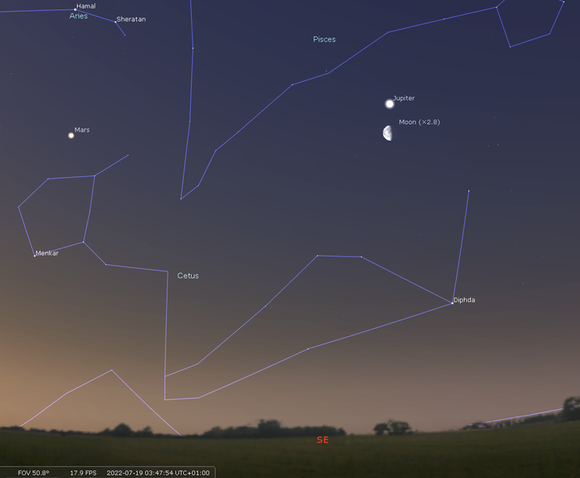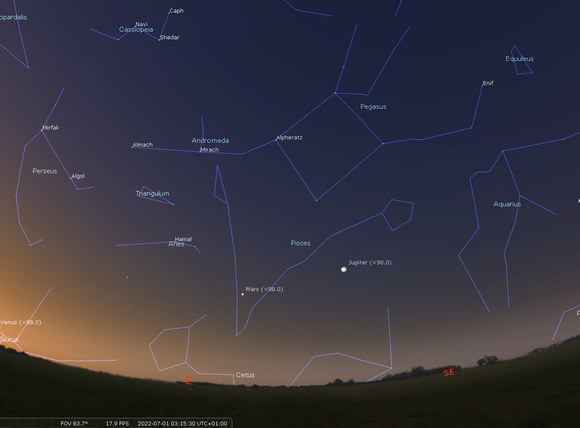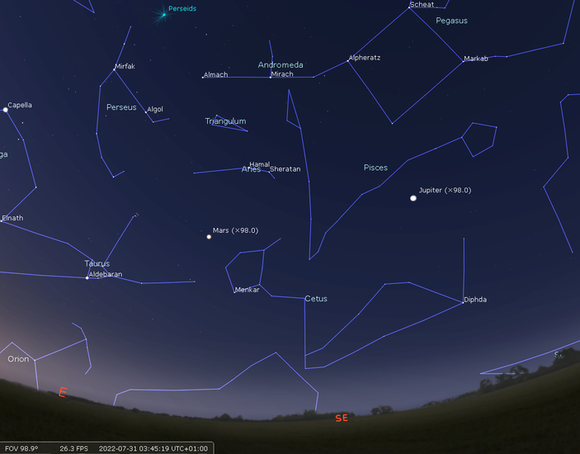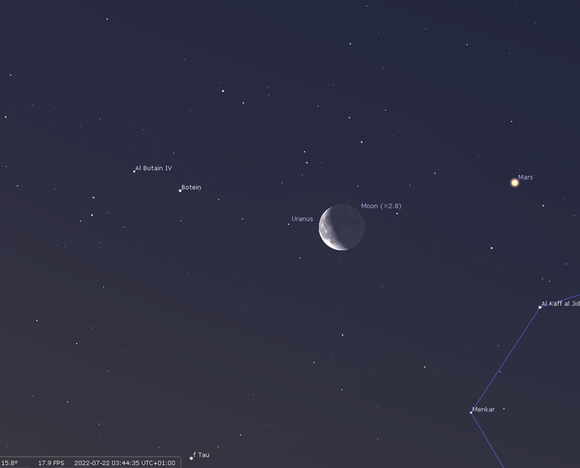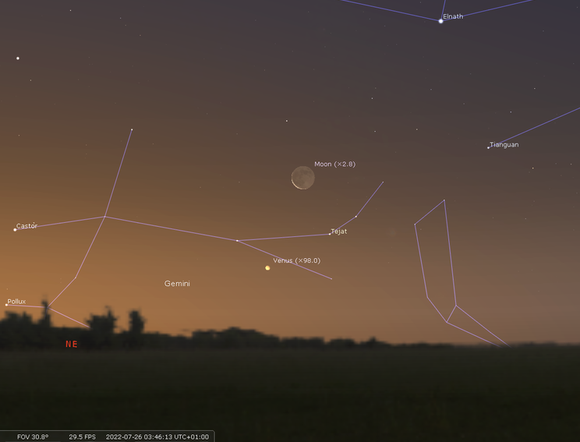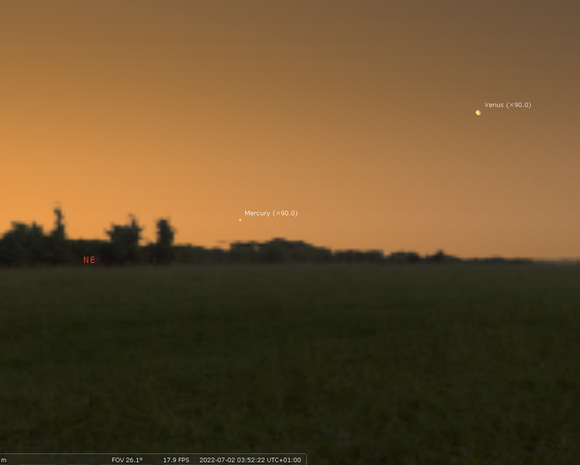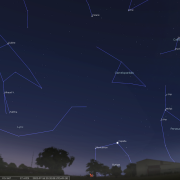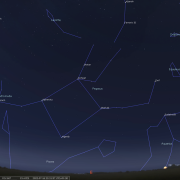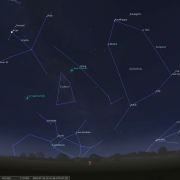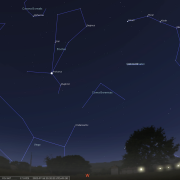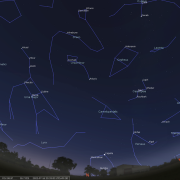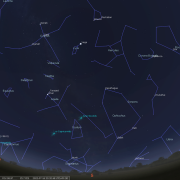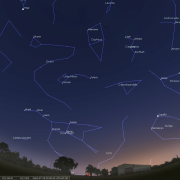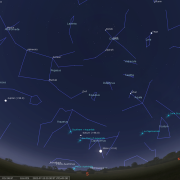In this month's Sky Notes:
- Planetary Skylights.
- July Meteors.
- Noctilucent Cloud sightings.
- July Night Sky.
- July 2022 Sky Charts.
Planetary Skylights - Brief
After the planetary barren evening skies of June, July will have something more to offer, with Saturn and eventually Jupiter emerging in the late evening sky, pre-midnight. The hour will be late before observations are possible, or very early before they become practical, dusk falling late until well into July. In reality both Saturn and Jupiter, along with Mars, should still be considered 'overnight' objects, with Venus joining them as the only true pre-dawn planet.
 Saturn emerges above the SE horizon by 23:15hrs at the start of July and with an apparent magnitude of +0.48 and pearly white lustre, appears quite conspicuous to the eye, brightening further still by the month's end. By the it will be on show by 22:00hrs. The rings of Saturn are always a most agreeable spectacle and remain favourably orientated with respect to Earth, the North Pole tilted toward us by around 15 degrees. This is slowly closing up again. Compared to last year Saturn will culminate (crossing the meridian due south) just a little higher; over 20 degrees from the latitude of Whitby, affording the chance of better 'seeing' through the eyepiece. It is those fleeting (occasionally more lengthy) moments of seeing that draw people to the eyepiece to gaze in wonder at the ring system and which define Saturn.
Saturn emerges above the SE horizon by 23:15hrs at the start of July and with an apparent magnitude of +0.48 and pearly white lustre, appears quite conspicuous to the eye, brightening further still by the month's end. By the it will be on show by 22:00hrs. The rings of Saturn are always a most agreeable spectacle and remain favourably orientated with respect to Earth, the North Pole tilted toward us by around 15 degrees. This is slowly closing up again. Compared to last year Saturn will culminate (crossing the meridian due south) just a little higher; over 20 degrees from the latitude of Whitby, affording the chance of better 'seeing' through the eyepiece. It is those fleeting (occasionally more lengthy) moments of seeing that draw people to the eyepiece to gaze in wonder at the ring system and which define Saturn.
A scope with an aperture of 80-100mm (3.5 - 4") will reveal the two brightest rings; ring A (the outermost) and ring B. These are separated by the Cassini Division. Ring C lies closest to the disk but is difficult to spot, especially when Saturn is rather low. To fully observe this requires scopes of 150mm (6"). Saturn has at least 60 moons most of which are very small, but you should at least spot Titan, its largest moon as a speck nearby. Titan is bright enough (mag+8.4) to be spied in binoculars. Titan takes just under 16 days to orbit round Saturn. Scopes of 200mm + (8") will also reveal Rhea, Tethys and Dione as well as Iapetus. The Moon lies below Saturn overnight of 15/16th.
 During the second half of July, Jupiter also makes a welcome return to the evening sky, trailng Saturn by approximately an hour over in the east. In practical terms, observations of Jupiter will be carried out overnight, though bear in mind nights are still short on darkness with skies brightening again by 03:30hrs.
During the second half of July, Jupiter also makes a welcome return to the evening sky, trailng Saturn by approximately an hour over in the east. In practical terms, observations of Jupiter will be carried out overnight, though bear in mind nights are still short on darkness with skies brightening again by 03:30hrs.
At magnitude -2.5 conspicuous Jupiter should be obvious as it rises in the ESE just below the faint stars of Pisces but within the borders of Cetus. At the very end of July Jupiter will have reached -2.7 in brightness and appear a whopping 45 arc seconds in diameter through the eyepiece. It will then be almost 40 degrees above the horizon by 03:45 hrs - well clear of the most turbulent air lower down. Jupiter will reach a stationary point on July 29th, thereafter it moves in retrograde motion (from east to west) until September.
Through the eyepiece Jupiter is a fine planetary specimen, the banding across the disk particularly fascinating to study, noting any changes in the Jovian atmosphere that may have occurred when out of ‘eyes’ way. The Great Red Spot (GRS), a colossal storm system, is readily visible to instruments of 80mm and above and of great interest to astronomers who monitor its size and shape. Over the last few decades the GRS has been diminishing in size and hue intensity, but perhaps may have reached its lower limits, definitely worth keeping tabs onThrough the eyepiece Jupiter is a fine spectacle, the banding across the disk is particularly fascinating to study and note what changes in the atmosphere are occuring over time. The Great Red Spot (GRS), a colosal storm system, is readily visible to instruments of 80mm and above and is of interest to astronomers who monitor its size and shape. Over the last few decades the GRS has been diminishing in size and hue intensity, but perhaps may have reached its lower limits, definately worth keeping tabs on.
Jupiter posseses the four Galilean moons (Io, Europa, Ganymede and Callisto), planetary sized worlds which orbit around their parent planet. All are of huge scientific interest to professional astronomers, but for amateurs it is the ever changing configuration, transits, shadow transits and occultations that are the draw. From next month the most favourable events will be highlighted once again. A waning gibbous moon lies immediately below Jupiter on July 19th.
.
Pre - Dawn Planets
 Mars just misses out on making a return to the evening sky this month, rising just after midnight, so should be considered as an overnight/pre-dawn object. The red planet is still a long way off from its early December opposition, but is starting to brighten and at mag +0.5 is readily conspicuous. Mars also appears considerably higher in the sky, around 30 degrees above the SE horizon by dawn, increasing in magnitude and elevation to +0.2 and almost 40 degrees respectively by the month’s end, allowing an observing window of 2 hours plus.
Mars just misses out on making a return to the evening sky this month, rising just after midnight, so should be considered as an overnight/pre-dawn object. The red planet is still a long way off from its early December opposition, but is starting to brighten and at mag +0.5 is readily conspicuous. Mars also appears considerably higher in the sky, around 30 degrees above the SE horizon by dawn, increasing in magnitude and elevation to +0.2 and almost 40 degrees respectively by the month’s end, allowing an observing window of 2 hours plus.
Through the eyepiece Mars remains a small disk (actually 84% gibbous), but is increasing to just over 8 arc seconds by August. Some very subtle markings may be noticeable in larger instruments, but it will be a good couple of months before observations really start to become interesting for the vast majority of amateur astronomers.
 Only Venus should be regarded as a genuine pre-dawn planet, skulking low above ESE horizon an hour or so before sunrise. The 'morning star' is by far the brightest planet visible in the dawn sky (magnitude - 3.9), easily outshining Jupiter way off to its right. Venus is however much lower and will require an unobstructed ENE horizon in which to locate it. Through the eyepiece, Venus is rather bland; a growing gibbous phase (90% by the end of the month) can be made out. If possible view on June 26th @ 03:15hrs when a very slim crescent moon lies above Venus. By the end of July Venus will have migrated towards the NE and be some 10 degrees above the horizon by 04:00hrs.
Only Venus should be regarded as a genuine pre-dawn planet, skulking low above ESE horizon an hour or so before sunrise. The 'morning star' is by far the brightest planet visible in the dawn sky (magnitude - 3.9), easily outshining Jupiter way off to its right. Venus is however much lower and will require an unobstructed ENE horizon in which to locate it. Through the eyepiece, Venus is rather bland; a growing gibbous phase (90% by the end of the month) can be made out. If possible view on June 26th @ 03:15hrs when a very slim crescent moon lies above Venus. By the end of July Venus will have migrated towards the NE and be some 10 degrees above the horizon by 04:00hrs.
 Finally, Mercury is technically visible in the early dawn sky, concluding a very challenging dawn apparition for UK observers. If viewing conditions allow over the first 3 or 4 days of July, look for Mercury barely a couple of degrees above the NE horizon around 03:50 hrs. You will require a favourable vantage point with the elusive inner most world readily apparent in binoculars (borderline naked eye) for half an hour only. Should skies be clear and you want to take on the challenge, scour the NE horizon a good hands span at arm's length below left of Venus. Because of the very low elevation telescopic views will be poor (to say the least) perhaps a fleeting glimpse of a quarter phase only.
Finally, Mercury is technically visible in the early dawn sky, concluding a very challenging dawn apparition for UK observers. If viewing conditions allow over the first 3 or 4 days of July, look for Mercury barely a couple of degrees above the NE horizon around 03:50 hrs. You will require a favourable vantage point with the elusive inner most world readily apparent in binoculars (borderline naked eye) for half an hour only. Should skies be clear and you want to take on the challenge, scour the NE horizon a good hands span at arm's length below left of Venus. Because of the very low elevation telescopic views will be poor (to say the least) perhaps a fleeting glimpse of a quarter phase only.
Meteor Activity - July
A number of lesser meteor showers occur during July.
- The Capri-Cornids have 3 maxima, July 8, 15, and 26, all with zenith hourly rates (ZHR) of less than 10, barely more than sporadic rates. Moon light from an almost full moon will washout the middle date, but not interfere with the other dates. Early morning hours will offer the best chance of catching a few shooting stars.
- The Alpha Cygnids peak on July 21st, but again rates are barely more than sporadic levels. Cygnus is well placed high in the SSE by midnight. Moon light will interfere slightly the moon being last Qtr
- The Delta-Aquarids are a little more prolific, peaking on July 30th with a ZHR of around 15. Moon light will not interfere.
Noctilucent Cloud - July sighting
A display of Noctilucent cloud from Whitby -July 13th 2020 -
not too disimilar to the one on June 22nd 2022 (image - Mark Dawson)
Displays of Noctilucent cloud have been few so far this summer, at least those already visible pre- midnight, despite there being a decent number of clear late evenings. The few sightings so far have been very low to the north horizon and chiefly post midnight, the most prominent of these being overnight June 22nd/23rd, and the early morning hours of June 28th. It was pure chance Mark noticed them at all, but was to sleepy capture them for posterity, being work- week days. The NCL season normally draws to a close by the end of July, so there is still time to witness a display. The pictured display was July 13th 2020 and not dissimilar to the June 28th event. Should you be more alert, and not half asleep around the midnight hour, do keep an eye out to the north.
July Night Sky
Early July nights are lighter than those in June and it's not until the back end of the month evenings are perceivably darkening once again. It is then a great time to familiarise yourself with the summer sky in the northern hemisphere. As dusk falls, look for the brightest of our summer luminaries high in the SSW. Arcturus is distinctly orange-yellow in hue, betraying its evolutionary state, a star that has evolved to become an orange giant with ‘one foot in the grave’ already.
By comparison the almost equally brilliant Vega, found overhead to the east, appears still in the flush of youth, its steely blue lustre an indication of this. At twice the mass of our Sun, Vega is however already halfway through its life; 'just' 450 million yrs old. Vega is the brightest member of the “summer triangle” the asterism first christened as such by Sir Patrick Moore in 1957. The two other members, Deneb and Altair, are also visible in the east. Deneb, faintest of the trio is found high to the NNE in the constellation of Cygnus- the swan, whilst Altair shines lower down in the SSE in Aquila the eagle.
By 23:30hrs, almost overhead in the WNW the familiar ‘saucepan’ outline of the Plough is conspicuous. Use the pointer stars, the back two in the “bowl” of the Plough to locate the pole star- Polaris, found due N fairly high up. Many 'non astronomers' mistake the bright star low to N horizon for the North Star, Capella in Auriga is actually a winter luminary, circumpolar from the UK but passes through this station during the summer months.
To the lower right of Polaris, midway up from the NNE horizon, the distinct pattern of Cassiopeia emerges well before midnight. Often called the “W” constellation, the group contains no bright stars; however their arrangement does catch the eye. When skies become fully dark, it is worth spending time exploring Cassiopeia thru binoculars or a telescope as it contains numerous star fields and clusters. Below Cassiopeia, extending up from the NNE horizon is the great hero Perseus, in which the radiant of the Perseus meteor shower resides.
Returning back to Arcturus, look for the delicate circlet of stars marking Corona Borealis - the Northern Crown, located upper left of the constellation of Bootes. The reasonably conspicuous star Alphecca or Gemma, sits midway in the starry circlet. To the left of Corona and high to the South, stands the great mythological hero Hercules, a large but ill-defined group. The central part of Hercules resembles a ‘keystone’, the centre stone of an arch, within which the deep sky object known as the great globular star cluster or M13, is visible in binoculars as a blurred star, but revealed through modest scopes as a glowing gossamer ball. The cluster contains upwards of half a million stars!
The huge sprawling shape of Ophuichus occupies much of the sky between Hercules and the S horizon, although none of its stars are particularly prominent. Just visible above the SW horizon is the bright fiery hue of Antares, chief star in the constellation of Scorpius, which unfortunately only partly rises from the UK. Following the Scorpion across the S horizon, Sagittarius is best identified by the ‘Teapot’ asterism, sitting almost on the horizon. The centre of our galaxy – the Milky Way is located between these two constellations in the sky, approximately 27,000 light years away.
July 2022 Sky Charts
Additional Image Credits:
- Planets and Comets where not otherwise mentioned: NASA
- Sky Charts: Stellarium Software and Starry Night Pro Plus 8
- Log in to post comments

